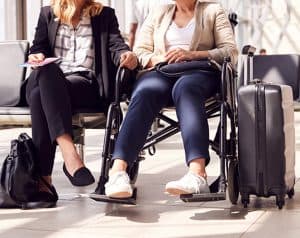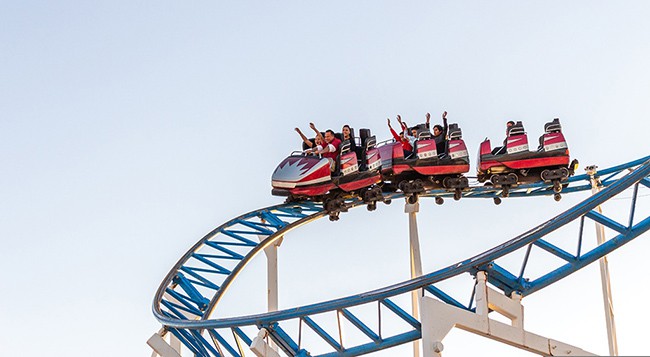Roller coasters, water slides, tilt-whirls, and Ferris wheels are all exciting ways to spend your summer afternoon, but when you use a wheelchair, these options might not be accessible to you. This does not mean that you should cancel your next trip to a theme park. In fact, The American Disabilities Act has set an accessibility standard that applies to amusement parks and their rides.
 Know Before You Go
Know Before You Go
In addition to visiting the park’s website to look for their disability guide, it is also helpful to reach out to the customer service team over the phone. When you speak with them, they can give you a plan to access their park and get the most out of their attractions.
You can also ask about discounted prices, complimentary admission for assistants, and fast-track policies for disabled visitors.
Mapping Out Your Trip – In More Ways Than One!
 In most cases visiting a large theme park requires a degree of travel. While top travel priorities for able-bodied people may include brainstorming what outfits to pack or what camera to buy, those living with a chronic illness or using a wheelchair may have some additional challenges in planning a trip. We recently asked our PatientsLikeMe members to provide their tips for traveling with a chronic illness:
In most cases visiting a large theme park requires a degree of travel. While top travel priorities for able-bodied people may include brainstorming what outfits to pack or what camera to buy, those living with a chronic illness or using a wheelchair may have some additional challenges in planning a trip. We recently asked our PatientsLikeMe members to provide their tips for traveling with a chronic illness:
“If possible, travel with a relative or friend. When making hotel reservations, remember that smaller hotels require less walking. Request a room on the first floor or near an elevator. Request a room with a grab bar in the shower. If traveling by airplane, request a straight-through flight and an aisle seat.” – PLM Member with Parkinson’s Disease who uses a wheelchair
For more inspiration and advice, read through some of our members’ travel tips and tricks.
You’ve Arrived
Once you arrive, the theme park generally provides handicapped parking spaces near the entrance, so you don’t have to trek across the parking lot. If you’re using public transport, such as a park-run shuttle bus or tram, be sure to contact the park or transport provider first to what accommodations they can make. Transport to and from the park can be very popular and crowded, so consider this when planning your trip.
When working with a third party and public transportation companies, be sure to know your rights. The Federal Transit Administration offers a helpful Q&A concerning wheelchairs and bus/rail services to guide you through the disability laws and your rights.
“I try and book all portions of my trip ahead of time if I can. Not just the hotel and airplane, I also see if I can book a car service or see if the public transportation routes are handicap friendly. This way, I don’t end up stranded if I can help it.” – PLM Member with Fibromyalgia and chronic back pain
Making Your Way Through the Park
 Theme parks can be sprawling and spread out across a wide area. With different “creative themes” in each section of the park, it is helpful to check the terrain you will be traveling across and plan your route accordingly. You may find a map on the park’s website, and if not, be sure to request one when you arrive. The map can also point you in the direction of the accessible toilets and quieter rest areas if you need to take a break. Exposure to the elements, crowds, and distances can be a lot for your body to handle; remember to listen to your body and take breaks when necessary. Check out these clever tips for managing your energy.
Theme parks can be sprawling and spread out across a wide area. With different “creative themes” in each section of the park, it is helpful to check the terrain you will be traveling across and plan your route accordingly. You may find a map on the park’s website, and if not, be sure to request one when you arrive. The map can also point you in the direction of the accessible toilets and quieter rest areas if you need to take a break. Exposure to the elements, crowds, and distances can be a lot for your body to handle; remember to listen to your body and take breaks when necessary. Check out these clever tips for managing your energy.
Some parks offer motorized wheelchairs and scooters for rent which can help you navigate the park faster. Call the park before you go and ask about their rental options and recommendations. Our members also recommend planning ahead for wheelchair maintenance:
“I like to pack a mini-chair repair kit when I travel. I throw in duct tape, allen wrenches, replacement screws, and my wheelchair owner’s manual. This way I can make quick repairs that keep my chair moving!” – PLM Member with Multiple Sclerosis
Finding the right equipment can be challenging and may require some trial and error. At PatientsLikeMe, our members have taken some of the leg work out for you! They have reviewed and rated hundreds of wheelchair and walker brands in our treatment review section. If you are looking for a different option or would like to share your experience, visit the PLM Treatment Reports today!
Now the Fun Begins!
 Look into special access passes when you buy your tickets. For example, parks often provide a pass or wristband, which allows you to access rides through a separate entrance from the main line. This can make it easier for you to get on the rides and, in some cases, eliminate a lengthy wait that could impact your condition.
Look into special access passes when you buy your tickets. For example, parks often provide a pass or wristband, which allows you to access rides through a separate entrance from the main line. This can make it easier for you to get on the rides and, in some cases, eliminate a lengthy wait that could impact your condition.
Just because you are in a wheelchair, it does not mean you can’t go on some of the more adventurous roller coasters and rides. PLM members have reported that an inverted roller coaster (where your legs and feet dangle from the ride) might be the most comfortable and accessible to people who use a wheelchair. Generally, on these coasters, you can roll your wheelchair up to the platform, allowing for a relatively unobstructed transfer. Depending on the nature of your disability, you may want to try a roller coaster that restrains you at the shoulders if you have limited trunk control. There are plenty of rides you can also access that don’t require a transfer.
Unfortunately, some rides are just not accessible for everyone, even when using the disabled entrance. Individual rides can have health and safety requirements, such as the ability to brace or to be able to walk a certain distance unaided in case of evacuation. Speak with guest services to see if they can guide you on the best rides for your condition.
It Keeps Getting Better
 Everyone deserves to have a great theme park experience. The good news is that several parks across the US are making it a priority that ALL of their guests can access the fun. While you may have to approach your experience differently, there are still plenty of options available at these parks for you to safely participate in. Some parks are better than others in offering a full experience for their disabled guests. So, when planning your next adventure, be sure to look through this guide to the ultimate wheelchair-friendly parks in the US!
Everyone deserves to have a great theme park experience. The good news is that several parks across the US are making it a priority that ALL of their guests can access the fun. While you may have to approach your experience differently, there are still plenty of options available at these parks for you to safely participate in. Some parks are better than others in offering a full experience for their disabled guests. So, when planning your next adventure, be sure to look through this guide to the ultimate wheelchair-friendly parks in the US!
This is just one of the many challenges you may be facing due to your disability or chronic condition. We want you to know that you are not alone, and PatientsLikeMe is here for you to share your experiences with people who are on the same road as you. Join the conversation today!

